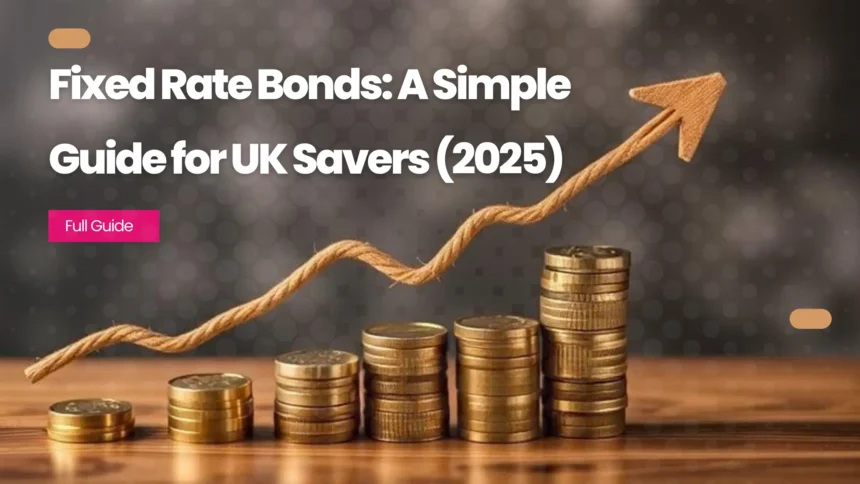If you’re looking for a safe and predictable way to grow your savings, fixed rate bonds could be the perfect solution. In this guide, we’ll explain what they are, how they work, their pros and cons, and answer common questions to help you decide if they’re right for you.
What is a Fixed Rate Bond?
A fixed rate bond (also called a fixed-term savings account) is a type of savings account where you lock away your money for a set period (e.g., 1, 2, or 5 years) at a guaranteed interest rate.
Unlike easy-access savings accounts, you can’t withdraw your money early without penalties—but in return, you get higher interest rates.
Key Features of Fixed Rate Bonds
Before we dive deeper, let’s look at the main features that make fixed rate bonds unique:
🔒 Locked-Term Savings
- Your money is tied up for a fixed period (1-5 years)
- Early withdrawals typically not allowed (or come with penalties)
💰 Guaranteed Interest Rate
- Rate stays the same for the entire term
- No surprises even if market rates fall
🏦 FSCS Protection
- Your money is safe up to £85,000 per bank
- Covers all UK-regulated providers
📈 Higher Interest Rates
- Typically offer better returns than easy-access accounts
- Longer terms usually mean higher rates
💷 Lump Sum Investment
- Usually require a minimum deposit (£500-£1,000+)
- One-time deposit (no regular additions allowed)
📅 Fixed Maturity Date
- Know exactly when you’ll get your money back
- Some banks offer maturity alerts
How Do Fixed Rate Bonds Work?
- Deposit a lump sum – You invest a one-time amount (usually from £500 to £100,000+).
- Choose a term – Common terms are 1-year, 2-year, 3-year, or 5-year bonds.
- Earn fixed interest – Your rate stays the same, regardless of market changes.
- Get your money back – At the end of the term, you receive your initial deposit plus interest.
Pros & Cons of Fixed Rate Bonds
✅ Advantages
✔ Higher interest rates – Better returns than easy-access accounts.
✔ Guaranteed returns – No risk of rate drops during the term.
✔ Low risk – Protected up to £85,000 per bank under the FSCS.
❌ Disadvantages
✖ No withdrawals – Early access usually means losing interest or paying a penalty.
✖ Interest rates locked in – If rates rise, you’re stuck with your original rate.
✖ Inflation risk – If inflation outpaces your rate, your money loses value in real terms.
Types of Fixed Rate Bonds
Different terms suit different savings goals:
| Term Length | Best For | Typical Interest Rate (2025) |
| 1-Year Fixed Bond | Short-term savers who want better rates than easy-access accounts. | ~4.5% – 5.5% |
| 2-Year Fixed Bond | Those happy to lock money away longer for slightly higher rates. | ~4.8% – 5.8% |
| 3-Year Fixed Bond | Medium-term savers who can wait for higher returns. | ~5.0% – 6.0% |
| 5-Year Fixed Bond | Long-term savers who don’t need access to cash. | ~5.2% – 6.2% |
(Rates are indicative and subject to change—always compare the latest deals.)
🔗 Want the best rates? Check our guides on:
- Best 1-Year Fixed Rate Bonds
- Best 2-Year Fixed Rate Bonds
- Best 5-Year Fixed Rate Bonds
Frequently Asked Questions (FAQs)
1. Can I withdraw money early from a fixed rate bond?
Most bonds do not allow withdrawals without penalties, which could mean losing some or all of your interest.
2. Are fixed rate bonds safe?
Yes—if your bank is FSCS-protected, your money is secure up to £85,000 per person, per institution.
3. What happens when my bond matures?
You’ll get your initial deposit + interest. Some banks may auto-renew your bond, so check the terms.
4. Are fixed rate bonds taxable?
Yes, interest earned counts as savings income. Basic-rate taxpayers get a £1,000 tax-free allowance (£500 for higher-rate taxpayers).
5. Can I open multiple fixed rate bonds?
Yes, you can spread savings across different terms and banks to maximise flexibility and FSCS protection.
6. Are fixed rate bonds a good idea?
They’re great if:
- You won’t need the money for 1-5 years
- You want higher, guaranteed interest
- You prefer zero risk (FSCS protected)Not ideal if you need emergency access or expect rates to rise soon.
7. Where can I get 5% interest in the UK?
As of 2025, these offer 5%+:
- 1-year bonds: 5.0%-5.5%
- 2-year bonds: 5.3%-5.8%
- NS&I bonds: Currently up to 6.2% (but read below!)
8. What do you mean by fixed rate bond?
It’s a savings account where:
- You lock money away (e.g., 2 years)
- The bank pays you the same interest rate the whole time
- You can’t withdraw early (usually)
9. Is NS&I a 6.2% fixed rate?
NS&I sometimes offers limited-time bonds (like their 6.2% 3-year bond in 2024). In 2025:
✔ Yes, but only for specific issues (check their site)
✔ No – their standard bonds are usually lower than banks
Final Verdict: Are Fixed Rate Bonds Right for You?
Fixed rate bonds are great if:
- You don’t need instant access to your savings.
- You want stable, guaranteed returns.
- You’re happy to lock in a rate even if interest rates rise later.
If you prefer flexibility, consider easy-access savings accounts or notice accounts instead.
🔗 Explore more savings options:
- Best Savings Accounts in the UK
- Fixed Rate Bonds vs. ISAs: Which is Better?
Disclaimer: This article is for informational purposes only. Rates and terms may change—always check with providers before opening an account.




